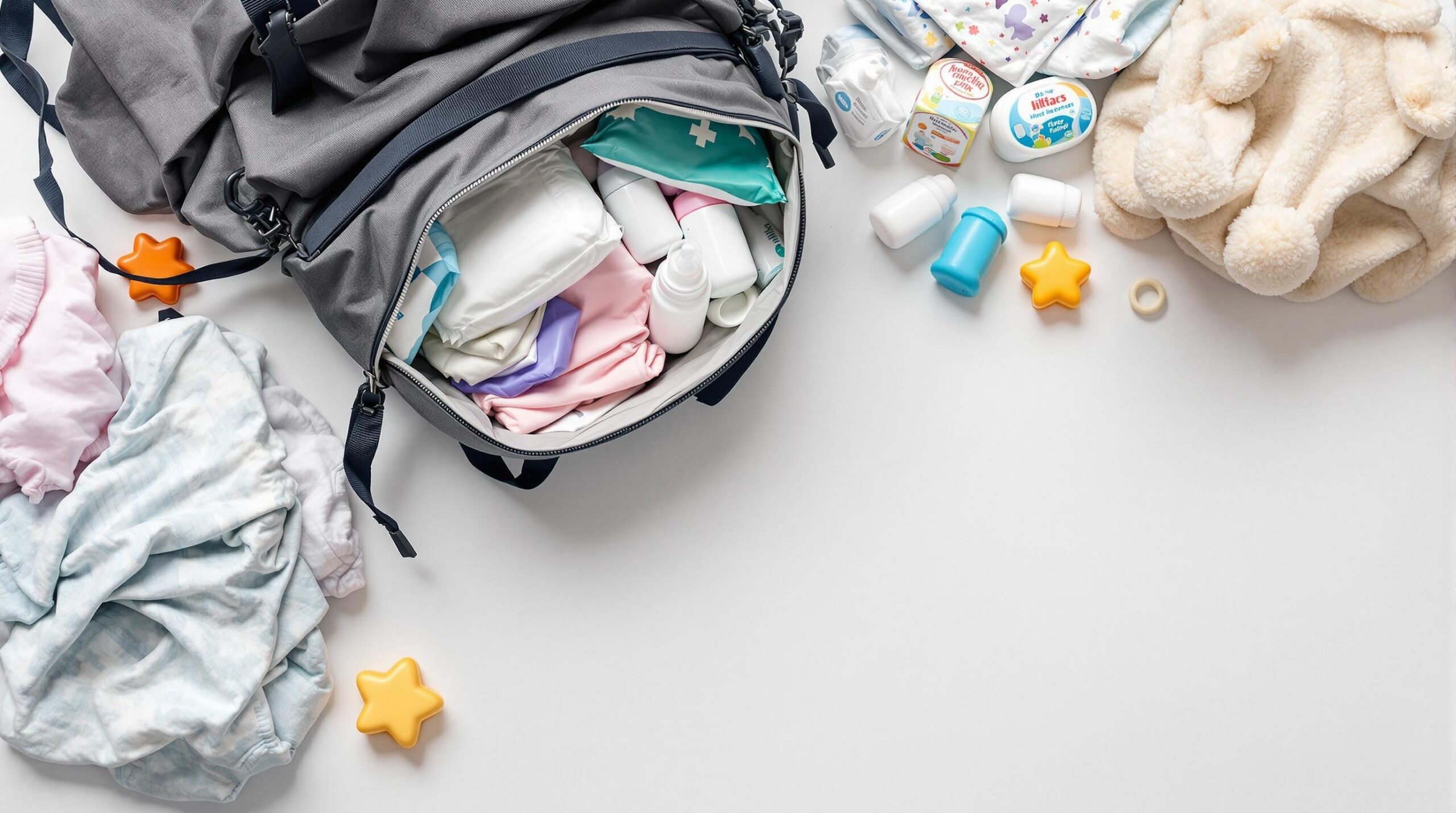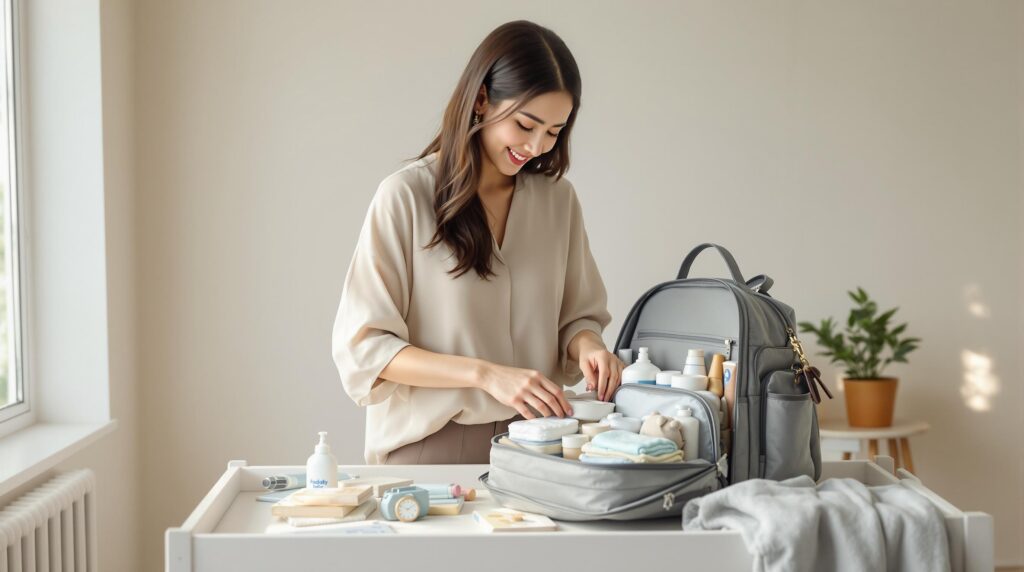Table of Contents
ToggleAs a parent, having a well-stocked diaper bag is essential for managing life on the go with your little one. It’s your mobile command center, equipped with everything you need to keep your baby happy, comfortable, and clean during outings. Let’s dive into the must-have items for your diaper bag and how to organize them efficiently.
Diaper Bag Essentials: Keeping Your Baby Comfortable and Clean
The cornerstone of any diaper bag is, unsurprisingly, diapers and wipes. But how many should you pack? It depends on your child’s age and diapering habits. Newborns can go through up to 10 diapers a day, while toddlers might need 4-6. A good rule of thumb is to pack one diaper for every two hours you’ll be out, plus a couple extra for good measure.
Wipes are indispensable for more than just diaper changes. They’re great for cleaning sticky hands and faces, wiping down public changing tables, and handling unexpected messes. Pack a travel-sized pack or transfer some to a reusable wipes container to save space.
Don’t forget a portable changing pad. It provides a clean, comfortable surface for diaper changes and can be easily wiped down between uses. Some diaper options come with built-in changing pads, but if yours doesn’t, a foldable, waterproof pad is a smart addition.
Pro tip: Create a “diaper change kit” by bundling a diaper, a few wipes, and a small tube of diaper cream in a large ziplock bag. This makes it easy to grab everything you need for a quick change without rummaging through your entire bag.

Clothing and Weather Preparedness
Babies have an uncanny ability to make messes at the most inconvenient times. That’s why packing at least one full change of clothes is crucial. Include socks, pants, a shirt, and undergarments if applicable. For longer outings or if you’re in a phase of frequent spit-ups or blowouts, consider packing two sets.
When choosing extra clothes, think about the weather and your baby’s activity level. Layering is key for adapting to temperature changes. In cooler weather, pack a light sweater or jacket. For warmer days, don’t forget a sun hat and lightweight, breathable clothing.
Here’s a quick clothing checklist:
- Onesie or bodysuit
- Pants or shorts
- Socks
- Sweater or light jacket
- Hat (sun hat for summer, warm hat for winter)
- Extra pair of shoes for toddlers
Remember, it’s better to have and not need, than to need and not have when it comes to baby clothes on the go!
Feeding on the Go: Bottles, Snacks, and Scheduling
Hunger waits for no one, especially not babies! Whether you’re breastfeeding or formula feeding, be prepared with clean bottles or sippy cups filled with appropriate liquids. For formula-fed babies, pre-measure formula powder in small containers and pack bottled water for mixing.
As your baby grows, incorporate healthy, easy-to-eat snacks. Good options include:
- Pureed fruits in squeezable pouches
- Soft fruits like bananas or avocados
- Cheerios or other baby-safe cereals
- Teething biscuits
- Cut-up vegetables for older babies and toddlers
Feeding schedules vary by age, but generally, newborns eat every 2-3 hours, while older babies might go 3-4 hours between feedings. Snacks for older babies and toddlers can be offered between meals as needed.
To keep snacks fresh and hygienic, use small, reusable containers or snack bags. Always wash your hands before handling food, and bring along hand sanitizer for quick cleanups. Remember to pack any necessary utensils, bibs, and burp cloths too!
Health and Safety Essentials
Being prepared for minor health issues can save you a lot of stress. Include any prescribed medications your child needs, and assemble a basic first-aid kit. According to the CDC, proper hand hygiene can prevent up to 30% of diarrhea-related illnesses and 20% of respiratory infections. Always pack hand sanitizer for those times when soap and water aren’t available.
A basic first-aid kit for your diaper bag should include:
- Band-aids in various sizes
- Antibiotic ointment
- Tweezers
- Small scissors
- Thermometer
- Pain reliever/fever reducer appropriate for your child’s age
Don’t forget sun protection! The Skin Cancer Foundation recommends using a broad-spectrum sunscreen with an SPF of 30 or higher. Apply sunscreen 30 minutes before sun exposure and reapply every two hours or after swimming or sweating. A wide-brimmed hat provides additional protection for your baby’s delicate skin.
In mosquito-prone areas, pack a child-friendly insect repellent. The American Academy of Pediatrics suggests using repellents containing 10% to 30% DEET for children older than two months. Always follow the product instructions carefully.
Entertainment and Developmental Tools
Keeping your little one entertained during outings can be a lifesaver. Pack a few lightweight, easy-to-clean toys and books. The American Academy of Pediatrics emphasizes the cognitive benefits of reading to children from an early age, so always include a board book or two.
For younger babies, consider:
- Soft, crinkly books
- Teething toys
- Rattles
- Small stuffed animals
For older babies and toddlers:
- Board books
- Small cars or figurines
- Stacking cups
- Crayons and a small notebook
A portable music player or phone app with soothing sounds or lullabies can be invaluable for calming a fussy baby. White noise, in particular, can help mask unfamiliar sounds and create a sense of comfort in new environments.
Parenting Resources and Emergency Information
While not strictly necessary, having quick access to parenting tips and developmental milestones can be reassuring. Consider keeping a small booklet or using a parenting app on your phone. These resources can help you track your baby’s progress and provide guidance on age-appropriate activities and behaviors.
It’s crucial to have emergency contact information readily available. Create a small card or note in your phone with:
- Pediatrician’s name and phone number
- Emergency contacts (family members or close friends)
- Your child’s health insurance information
- Any allergies or medical conditions your child has
Having this information at your fingertips can save precious time in an emergency situation.
Organizing Your Diaper Bag for Efficiency
A well-organized diaper bag can make all the difference when you’re out and about. Look for a bag with multiple compartments to keep items separated and easily accessible. Some parents find it helpful to use small, labeled containers or pouches within the bag for different categories of items.
Here’s a suggested organization system:
- Diapering supplies in one compartment
- Feeding items in another
- Clothes in a separate pouch
- Toys and books in an easily accessible outer pocket
- First-aid and medication in a secure, separate container
Create a checklist of essential items and keep it in your bag. Before each outing, quickly run through the list to ensure you haven’t forgotten anything crucial. Some parents find it helpful to restock the bag as soon as they return home, ensuring it’s always ready for the next adventure.
Remember, the key to an efficient diaper bag is to pack light but smart. Regularly review the contents and remove items your growing child no longer needs, replacing them with age-appropriate alternatives.
Special Considerations for Children with Unique Needs
For children with special medical needs, the diaper bag becomes even more crucial. In addition to the standard items, you might need to pack:
- Specialized medical equipment
- Extra medication doses
- Detailed care instructions for caregivers
- Special dietary items
Don’t forget comfort items like a favorite toy or blanket, which can be especially important for children who might feel anxious in new environments or medical settings.
Adapting your diaper bag for a child with special needs might require some trial and error. Work closely with your child’s healthcare providers to ensure you’re prepared for various situations. There are also support groups and online communities that can provide valuable advice and tips from other parents in similar situations.
Remember, every child is unique, and what works for one might not work for another. The key is to be flexible and adjust your diaper bag contents as your child grows and their needs change. With a well-stocked, organized diaper bag, you’ll be prepared for whatever adventures come your way as you embark on parenthood.
By keeping these essentials in mind and organizing your diaper bag efficiently, you’ll be well-prepared for outings with your little one. Remember, the goal is to make your time away from home as smooth and enjoyable as possible. Happy parenting!
Sources:
National Institute of Child Health and Human Development (NICHD)
National Center for Education Statistics
U.S. Department of Education
Centers for Disease Control and Prevention (CDC)
American Academy of Pediatrics (AAP)
World Health Organization (WHO)
National Library of Medicine
U.S. Department of Health and Human Services
Office of Child Care
HealthyChildren.org












